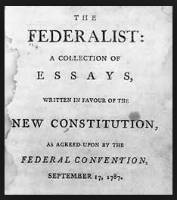
This lesson addresses writing linear equations when given a graph. Students will use their knowledge of slope and y-intercept to analyze linear graphs and represent what they see graphically as an equation. This lesson also offers an opportunity to reiterate the meaning of slope and y-intercept, while... Read more »
Writing Linear Equations: Graphs
Course
Subject
Grade Level
Standards

This grammar lesson will engage students in recognizing, identifying, and creating active or passive voice in their writing. The use of active and passive voice is demonstrated through the short story, "The Monkey's Paw," although any piece of literature could be substituted. This lesson includes optional... Read more »
Grammar/Language Usage
Subject
Course
Grade Level
Standards

In this lesson, students will use an investigation to explore rational functions. Students will formalize their understanding of a rational function and continue to investigate the relationship between the equation of a simple rational function and its graph. Read more »
Investigating Graphs of Rational Functions
Grade Level
Course
Subject
Standards

How do you persuade others? How did the characters in Shakespeare's "Julius Caesar" use ethos, pathos, and logos to sway the minds of the Roman people? This lesson explores the three modes of persuasion and invites students to analyze and notate the speeches in Shakespeare's tragedy for ethos, pathos,... Read more »
Julius Caesar
Subject
Course
Grade Level
Standards

This lesson will break down the components of a function and the relationship it has to real-world contexts. Students will recall their knowledge of inputs and outputs with a function machine. Students will simplify functions and then evaluate the functions. Students will practice simplifying polynomials... Read more »
Function Notation
Course
Subject
Grade Level
Standards

This lesson invites students to see linear and nonlinear functions—here, represented by tables, graphs, and equations—in a real-world context. Students will work to find relationships between real-world data points based on the situation at hand. Students will also identify linear and nonlinear relationships,... Read more »
Linear vs. Nonlinear Functions
Course
Subject
Grade Level
Standards

Interdependence of Science, Engineering, and Technology on Society and the Natural World
Grade Level
In this lesson on the interdependence of science, engineering, and technology, students will use the example of snake venom to explore how natural resources can be used to make synthetic products that humans rely on. Students will learn and practice research strategies and evaluate sources. Finally,... Read more »
Interdependence of Science, Engineering, and Technology on Society and the Natural World
Grade Level
Subject
Standards

In this lesson, students will learn about the concepts of growth mindset and neuroplasticity, how to identify their own mindsets, and methods to change them. Students will play through Advance U: The TALENT Machine, a digital game-based learning (DGBL) module, to explore these concepts in an interactive... Read more »
Mindset and Neuroplasticity
Related
Grade Level
Subject
Course
Standards

Students will listen to the lyrics from Hamilton to consider why the US Constitution needed to be defended. In collaborative groups, students will work to understand and create point-of-view statements for both Federalists' and Anti-Federalists' viewpoints on ratifying the U.S. Constitution. Next, students... Read more »
Ratification of the Constitution Debate
Subject
Course
Grade Level
Standards

Students will examine the book "If You Give a Mouse a Cookie" by Laura Joffe Numeroff to learn about the conditional mood. After deconstructing, reconstructing, and creating their own conditional sentences, students will write collaborative Chain Stories in a narrative style similar to Joffe's book,... Read more »
Conditional Statements
Subject
Course
Grade Level
Standards

In this lesson, students will learn the relationship between position, velocity, speed, and acceleration to solve real-world problems involving motion along a line. Students are expected to know the chain rule and how to find higher-order derivatives for both power and trigonometric functions before... Read more »
Connecting Position, Velocity, and Acceleration
Grade Level
Course
Subject
Standards

This lesson provides an overview of ethical theory and integrity through discussion, reflection, and game-based learning. Through this lesson, students will gain a basic understanding of three common ethical frameworks: deontology, consequentialism, and virtue theory. They will come to understand that... Read more »
Ethics
Related
Grade Level
Subject
Course
Standards

Students will examine different types of insurance and learn about what each type insures. They will identify appropriate amounts of insurance, learn insurance terms, and learn how insurance deductibles work. This lesson includes optional modifications for distance learning. Resources for use in Google... Read more »
Standard 11: Insurance
Related
Grade Level
Subject
Course
Standards

In this lesson about the Emancipation Proclamation and expanding the goals of the Civil War, students will analyze the Emancipation Proclamation in comparison to an excerpt from President Lincoln's first inaugural address. Students will work in groups using a Card Sort strategy and Paired Text Analysis... Read more »
Expanding the Goals of the Civil War
Subject
Course
Grade Level
Standards

In this lesson about the journalism writing process and the role of a copy editor, students will explore the importance of grammar and style. Students will work in groups to identify the key elements of a news story through a Card Sort. Then, students will work independently to practice editing a paragraph... Read more »
Copy Editing and the Writing Process
Related
Subject
Course
Grade Level
Standards

In this lesson, students explore the relationship between a set of numbers and the constraints of an inequality. They will write, graph, and identify solutions to inequalities and connect these to real-world scenarios when applicable. Read more »
One-Step Inequalities
Course
Subject
Grade Level
Standards

This lesson is an extension of the "Pie > Everything" lesson series and adds a second variable to the equation. The goal of this lesson is for students to understand and find possible solutions for two-variable inequalities. Students will translate real-life problems into linear inequalities and make... Read more »
Inequalities With Two Variables
Course
Subject
Grade Level
Standards

Colloquial language is informal and consists of words or phrases known primarily to native speakers of a language. In this lesson, students will examine not only how familiar they are with English colloquialisms, but also how often these colloquialisms are used in our speaking and writing, and the effect... Read more »
Colloquial Language
Subject
Grade Level
Standards

This lesson introduces students to properties of real numbers, equality, and inverse operations for solving linear equations. The objective is for students to understand how to isolate a variable in two-step equations by applying properties of rational numbers. In the next lesson, students will advance... Read more »
Solving Two-Step Equations
Course
Subject
Grade Level
Standards

In this lesson, students build on prior knowledge of solving equations to learn how to solve absolute value equations. Students then compare and contrast four types of equations including two-step, multi-step, literal, and absolute value equations. This is the fourth lesson in the four-part "Journey... Read more »
Absolute Value Equations
Course
Subject
Grade Level
Standards

This lesson focuses on the properties of real numbers, properties of equality, and inverse operations to help students deepen their understanding of solving linear equations. Students will learn to isolate variables and apply this knowledge to more complex problems. By the end of the lesson, students... Read more »
Solving Multi-Step Equations
Course
Subject
Grade Level
Standards

Polygons and the Exterior Angle Sum Theorem
Grade Level
Students will explore the relationships between exterior angles in regular and irregular polygons to determine the sum of exterior angles, and they will apply that knowledge to solve problems. To complete this lesson, students need to know the interior angle sum theorem. See the "Department of the Interior... Read more »
Polygons and the Exterior Angle Sum Theorem
Course
Subject
Grade Level
Standards

In this lesson, students will explore different research methods used by sociologists. Students will work in groups to analyze different readings and summarize what they have read. To extend their learning, students will create visual representations of the different research methods to display across... Read more »
The Foundations of Sociology
Related
Grade Level
Subject
Course
Standards

In this geometry lesson, students will recall vocabulary about a circle, use their knowledge of midpoint and distance formulas to write the equation of a circle, and explore the connection between the equation of a circle and the Pythagorean Theorem. This is a multimodality lesson, which means it includes... Read more »
Writing the Equation of a Circle
Course
Subject
Grade Level
Standards

This lesson focuses on how to analyze and solve systems of linear equations by using the graphing method. The goal is for students to use prior knowledge to expand their understanding of equations and how they connect to real-world scenarios. Students will be able to identify, solve, and write equations... Read more »
Systems of Linear Equations: Graphing
Grade Level
Course
Subject
Standards

In this lesson, students will be introduced to imaginary numbers and their history. Students will learn how to simplify the square root of a negative number and how to simplify i to a power. Before beginning this lesson, students need to (1) know how to simplify the square root of a whole number and... Read more »
Understanding and Simplifying Imaginary Numbers
Grade Level
Course
Subject
Standards

Systems of Linear Equations: Substitution and Elimination
Grade Level
This lesson focuses on how to analyze and solve systems of linear equations by using the substitution and elimination methods. Students will use their prior knowledge of the components of a system to solve problems algebraically. Students will identify, solve, and write equations using substitution... Read more »
Systems of Linear Equations: Substitution and Elimination
Grade Level
Course
Subject
Standards

To complete this lesson, students need to know how to simplify the square root of a negative number and how to simplify i to a power.* This lesson is contained within an escape room. Students will navigate through a spaceship and, along the way, will perform operations on complex numbers so they can... Read more »
Operations with Complex Numbers
Related
Grade Level
Course
Subject
Standards

In this lesson, students will engage in several activities to understand Machiavelli's political writing, "The Prince." Students analyze excerpts from "The Prince," view a video about Machiavelli, participate in an activity to examine Machiavellian characteristics, and have a class debate about the... Read more »
The Political Thought of Machiavelli
Grade Level
Subject
Course
Standards

In this lesson, students will recall properties of exponents and how to simplify square roots and cube roots. Then, students will learn how to write radical expressions as expressions with rational exponents and vice versa. Students will use this knowledge to simplify expressions using either approach.... Read more »
Rewriting Rational Exponents and Radicals
Grade Level
Course
Subject
Standards

In this lesson, students will recall solving quadratic equations and rewriting radical expressions as expressions with rational exponents and vice versa. Students will learn how to solve equations with rational exponents and radicals. Then, students will apply this new knowledge to both mathematical... Read more »
Solving With Rational Exponents and Radicals
Grade Level
Course
Subject
Standards

In this lesson, students will recall solving equations with rational exponents and radicals. Using graphs, students will recall evaluating and solving equations with function notation. Students then will learn how to address extraneous solutions and why they exist. Students will apply this new knowledge... Read more »
Extraneous Solutions
Grade Level
Course
Subject
Standards

In this lesson, students will use their knowledge of domain and range to match pictures of graphs of rational functions with their corresponding domains and ranges. Students will learn about asymptotes, including what they are and how to find vertical and horizontal asymptotes of rational functions.... Read more »
Graphing Rational Functions
Grade Level
Course
Subject
Standards

In this lesson, students will work with rational functions that have 0, 1, or 2 vertical asymptotes and 0 or 1 horizontal asymptotes. Students will explore the relationship between the equation and graph of a rational function, learn what causes different types of asymptotes, and apply their knowledge... Read more »
Graphing Rational Functions
Grade Level
Course
Subject
Standards

In this lesson, students discuss and analyze the ways in which genetics and the environment play a role in human development. Students participate in a Four Corners activity, a Card Sort, and an article analysis, and then extend their learning by viewing a video about an experiment that separated triplets... Read more »
Nature vs. Nurture
Grade Level
Subject
Course
Standards

In this lesson, students will discover how to evaluate logarithms and use that knowledge to write equations in logarithmic and exponential forms. Students will learn how to solve exponential equations with and without using logarithms and then apply their knowledge to solve real-world problems involving... Read more »
Solving Exponential Equations
Grade Level
Course
Subject
Related
Standards

In this lesson, students will discover properties of logarithms. Students will use the properties to work through a proof of the change of base formula, to solve logarithmic equations, and to evaluate logarithmic expressions. Prerequisites for this lesson include solving exponential equations using... Read more »
Solving Logarithmic Equations
Grade Level
Course
Subject
Standards

In this lesson, students will learn how to graph and analyze piecewise functions. The piecewise functions in this lesson will have a maximum of three branches, which could contain any combination of linear, quadratic, and exponential branches. (Note: This lesson is written so that it could be taught... Read more »
Graphing and Analyzing Piecewise Functions
Grade Level
Course
Subject
Standards

In this lesson, students will use their knowledge of functions and function notation to perform basic operations on functions. Students will learn how to find domain restrictions caused by function operations. This lesson should be taught after students learn about radical functions, as using notation... Read more »
Basic Operations and Domain Restrictions
Grade Level
Course
Subject
Standards
In this lesson, students are introduced to function composition through a real-world scenario and pattern recognition. Students will learn composition notation and review domain restrictions caused by function operations. Students will use function composition to determine if functions are inverses.... Read more »
Function Composition
Grade Level
Course
Subject
Standards

In this lesson, students will recall expanding polynomials and factoring quadratics. Students will learn how to factor polynomials with two, three, or four terms: difference of two squares, sum or difference of two cubes, trinomials of the quadratic form that are not quadratics, and grouping. Students... Read more »
Factoring Polynomials
Grade Level
Course
Subject
Related
Standards

In this lesson, students will discover the attributes of three systems of government by discussing advantages and disadvantages of each type and then sorting characteristics of each type. Students will reflect on potential issues faced by citizens living under each type of system and will summarize... Read more »
Unitary, Federal, and Confederal Systems of Government
Grade Level
Subject
Course
Standards

In this lesson, students will explore the culture of the Seminole tribe and their patchwork. They will then use these patterns to explore transformations, specifically translations represented graphically, algebraically, verbally, and with vectors. Students will apply what they have learned to create... Read more »
Translations: Seminole Patchwork
Course
Subject
Grade Level
Related
Standards

In this lesson, students will explore the culture of the Osage tribe and their ribbonwork. Students will apply what they have learned about math and indigenous cultures to create their own ribbonwork design and demonstrate their understanding of reflections and reflective symmetry. Prerequisite knowledge... Read more »
Reflections: Osage Ribbonwork
Course
Subject
Grade Level
Related
Standards

In this lesson, students will explore the culture of the Plains tribes and their Star Quilts. They will then use patterns to explore rotations and discover algebraic rules for common rotations. Students will apply what they learn to create their own quilt block and demonstrate their understanding of... Read more »
Rotations: Plains Star Quilts
Course
Subject
Grade Level
Related
Standards

In this lesson, students will explore the culture of Native Americans and their beadwork. They will then use patterns to explore dilations and discover the relationship between the center of dilation, the preimage, and the image. Students will apply what they have learned to create their own beadwork... Read more »
Dilations: Beadwork
Course
Subject
Grade Level
Related
Standards

Composition of Transformation: Fashion Design
Grade Level
In this lesson, students will explore the mathematics behind fashion design and summarize their knowledge of transformations. They will then apply what they have learned to solve a puzzle and demonstrate their understanding of composition of transformations. Prerequisite knowledge for this lesson includes... Read more »
Composition of Transformation: Fashion Design
Related
Course
Subject
Grade Level
Standards

Students will apply what they have learned during this lesson series—Pythagorean, sum, difference, and double-angle identities—to navigate through a pirate-themed escape room. They will look at trigonometric identities graphically and algebraically. Students will use trigonometric identities to evaluate... Read more »
Sum, Difference, and Double-Angle Identities
Grade Level
Course
Subject
Standards

In this lesson, students first consider what they are motivated by, and then match descriptor cards with the four types of operant conditioning. Next, students summarize a reading and a video about Operant Conditioning before writing their own operant conditioning scenario and groups, and then sharing... Read more »
Operant Conditioning Learning Theory
Grade Level
Subject
Course
Standards

Moving past the First, Outer, Inner, Last (FOIL) method used for multiplying two binomials, this lesson introduces students to other methods for multiplying polynomials. Students recall properties of exponents and explore different methods of multiplying binomials. Students apply this knowledge to multiply... Read more »
Beyond FOILing
Grade Level
Course
Subject
Related
Standards

In this lesson, students will explore slope fields by visualizing a toy boat being moved by the current of a stream and a paper airplane moving through the air. Students will watch an interview of a meteorology researcher, then learn how to create and interpret slope fields given a differential equation.... Read more »
Meteorology and Wind Maps
Grade Level
Course
Subject
Standards

In this lesson, students will explore the relationship between piecewise functions and payroll taxes, specifically FICA (Federal Insurance Contributions Act) taxes. Students will learn how piecewise functions can be represented verbally, algebraically, graphically, and numerically. The tax information... Read more »
FICA and Functions
Related
Grade Level
Subject
Course

In this lesson, students will use their knowledge of derivatives and pattern-recognition skills to find antiderivatives. Students will begin with the power rule for integration, evaluate the indefinite integral of basic trigonometric expressions, then learn how to integrate with u-substitution. Students... Read more »
Integration by Substitution
Grade Level
Course
Subject
Standards

In this lesson, students learn to analyze relationships in bivariate data by exploring scatter plots and calculating the correlation coefficient. Prerequisite knowledge for this lesson includes z-scores using summation notation (sigma), mean (x bar), and standard deviation. Students build their understanding... Read more »
Correlation Coefficient
Related
Grade Level
Course
Subject
Standards

This lesson focuses on the relationship between a set of numbers and the constraints of an inequality. Students write, graph, and identify solutions to inequalities, connecting them back to real-world scenarios when applicable. Read more »
Multi-Step Inequalities
Course
Subject
Grade Level
Standards

In this lesson, students will explore the culture of the Osage tribe and their ribbonwork. Students will apply what they have learned about math and indigenous cultures to create their own ribbonwork design and demonstrate their understanding of reflections. Prerequisite knowledge for this lesson includes... Read more »
Reflections and Osage Ribbonwork
Related
Grade Level
Course
Subject
Standards

In this English ACT prep activity, students will focus on usage conventions. First, students will identify what is “not quite right” with some poor grammar depicted on memes. Then, students review seven of the most prevalent usage standards through a Card Matching activity. Finally, students apply their... Read more »
Target Audience
Calendar Placement
Group Size
Intention Or Purpose
College & Career Readiness Framework
Related

In this lesson, students will explore the history and societal impact of fraternities and sororities. Students will explore new vocabulary and read about the history behind multicultural Greek organizations. They will then watch interviews with members of Greek organizations who share their personal... Read more »
Target Audience
Calendar Placement
Group Size
Intention Or Purpose
ICAP (Individual Career Academic Planning)
Family Engagement
College & Career Readiness Framework

In this activity, students will increase their media literacy skills through exploring student-created news websites and analyzing the differences between hard and soft news reporting. Additionally, students will learn how to identify clickbait-style headlines and demonstrate their understanding by... Read more »
Target Audience
Calendar Placement
Group Size
Intention Or Purpose

